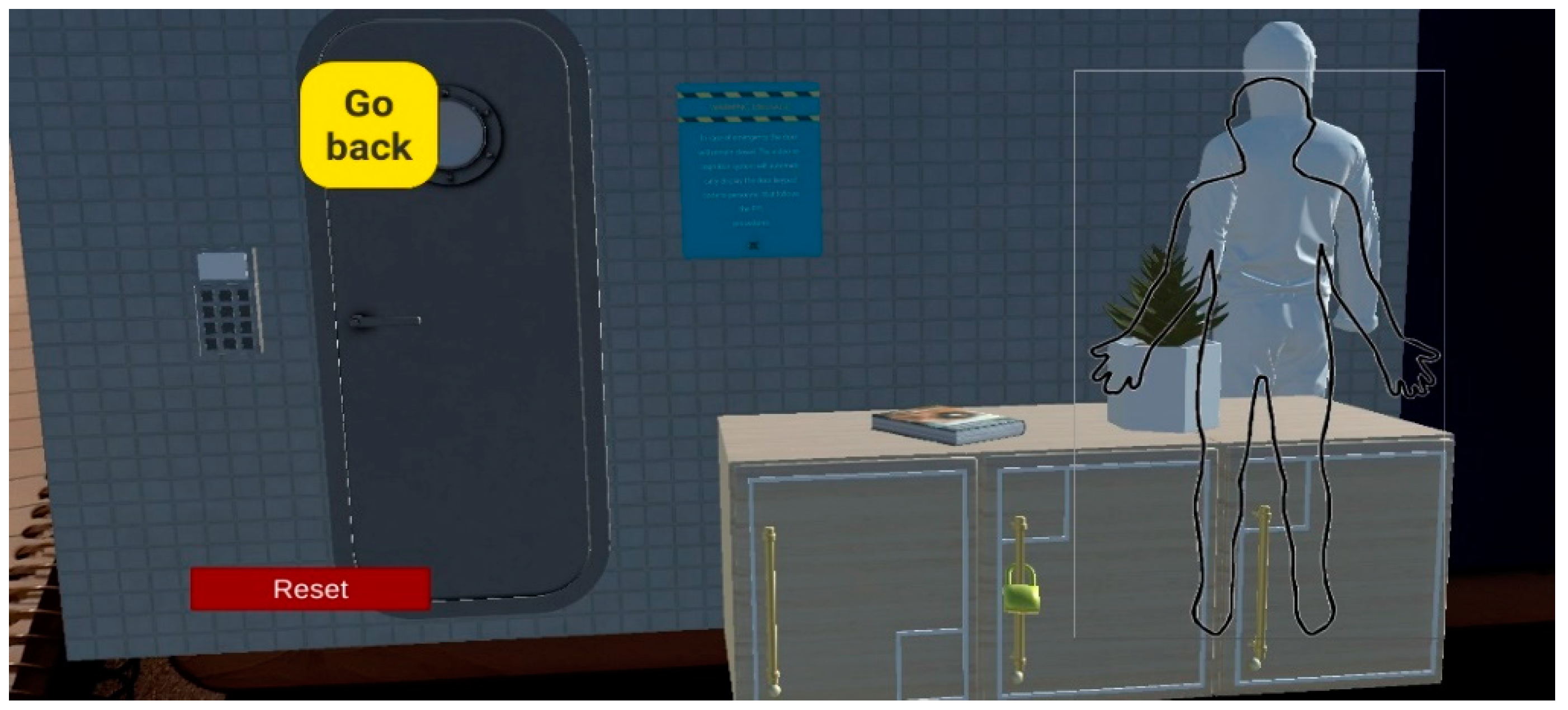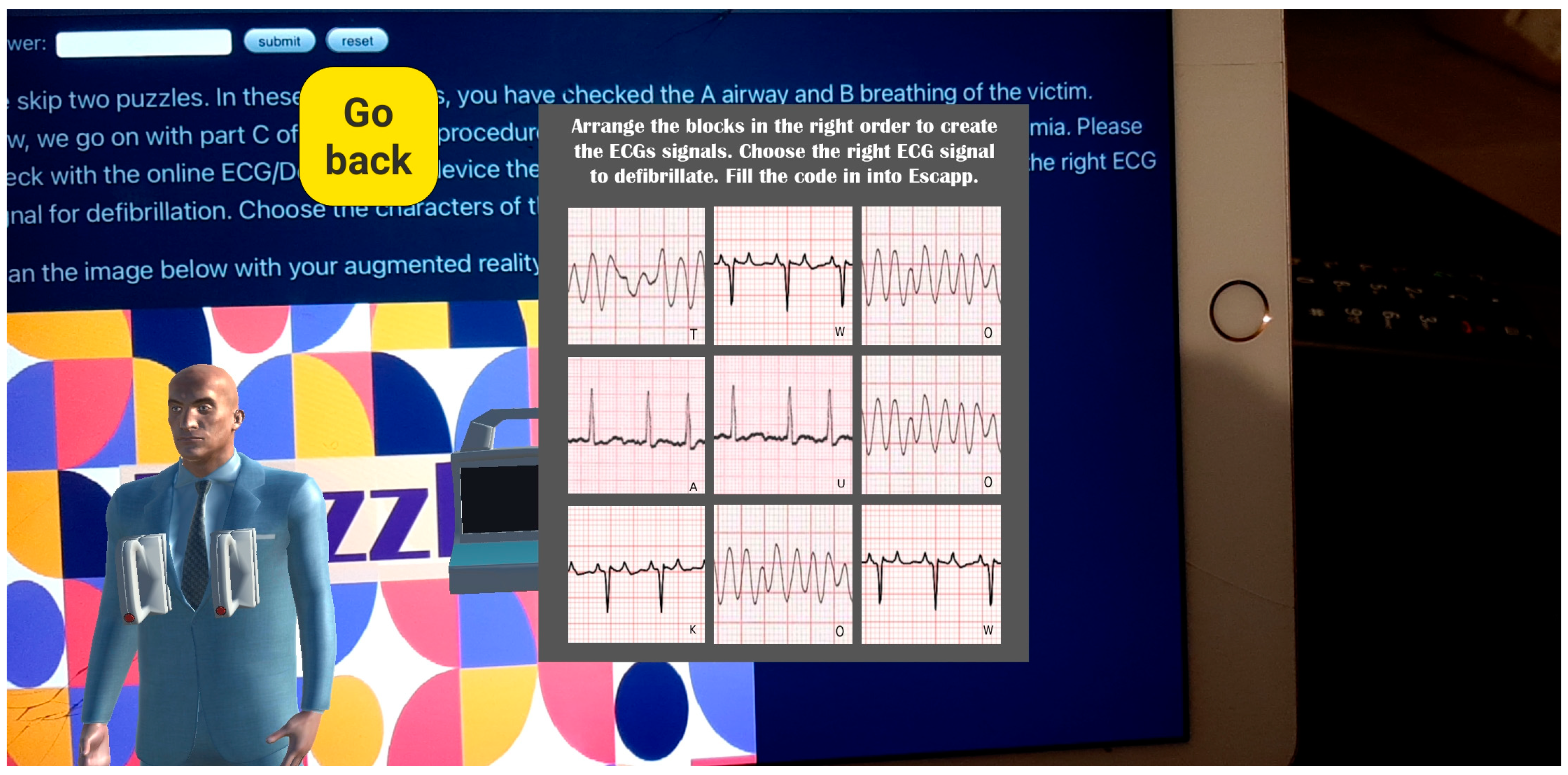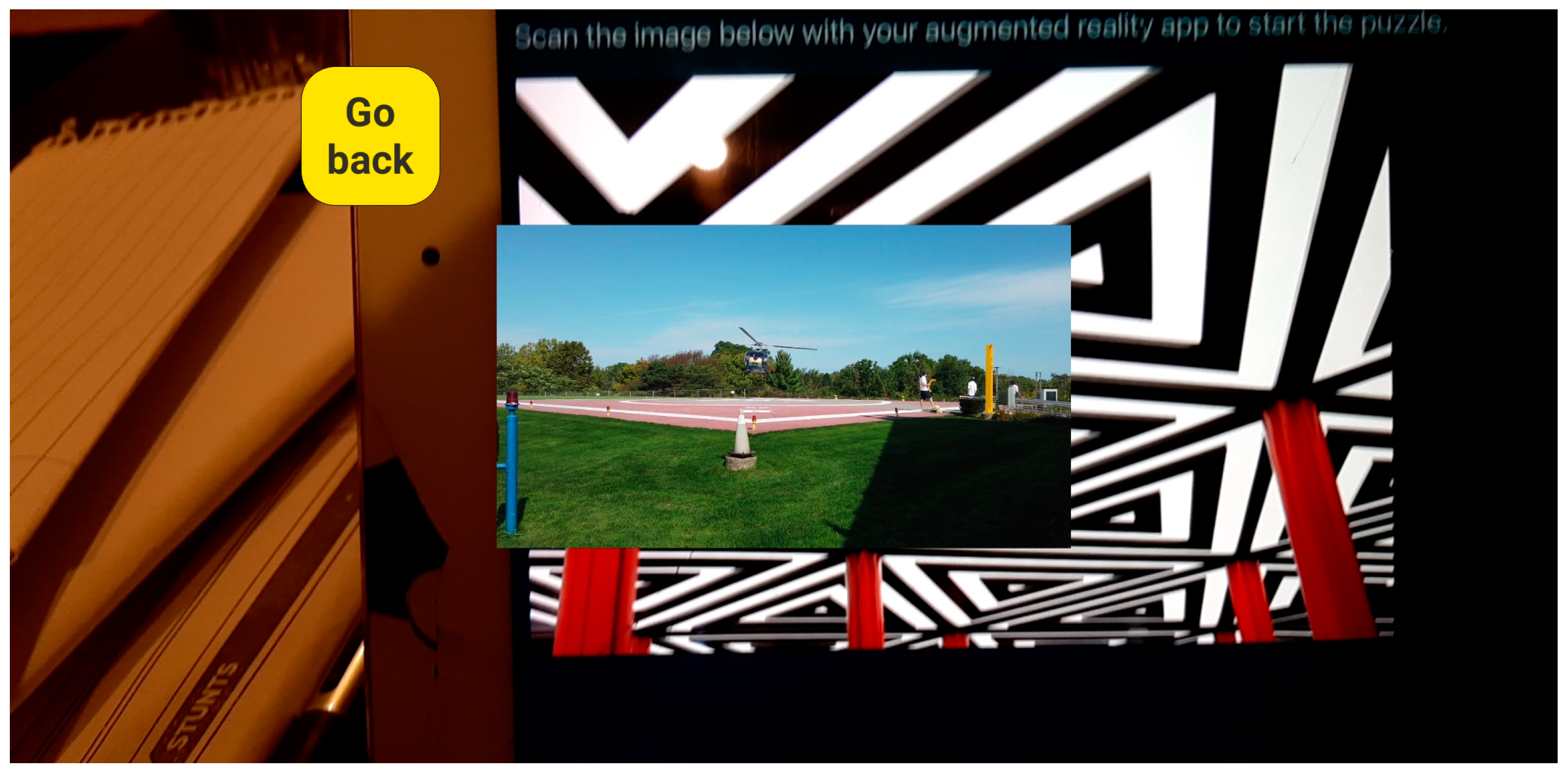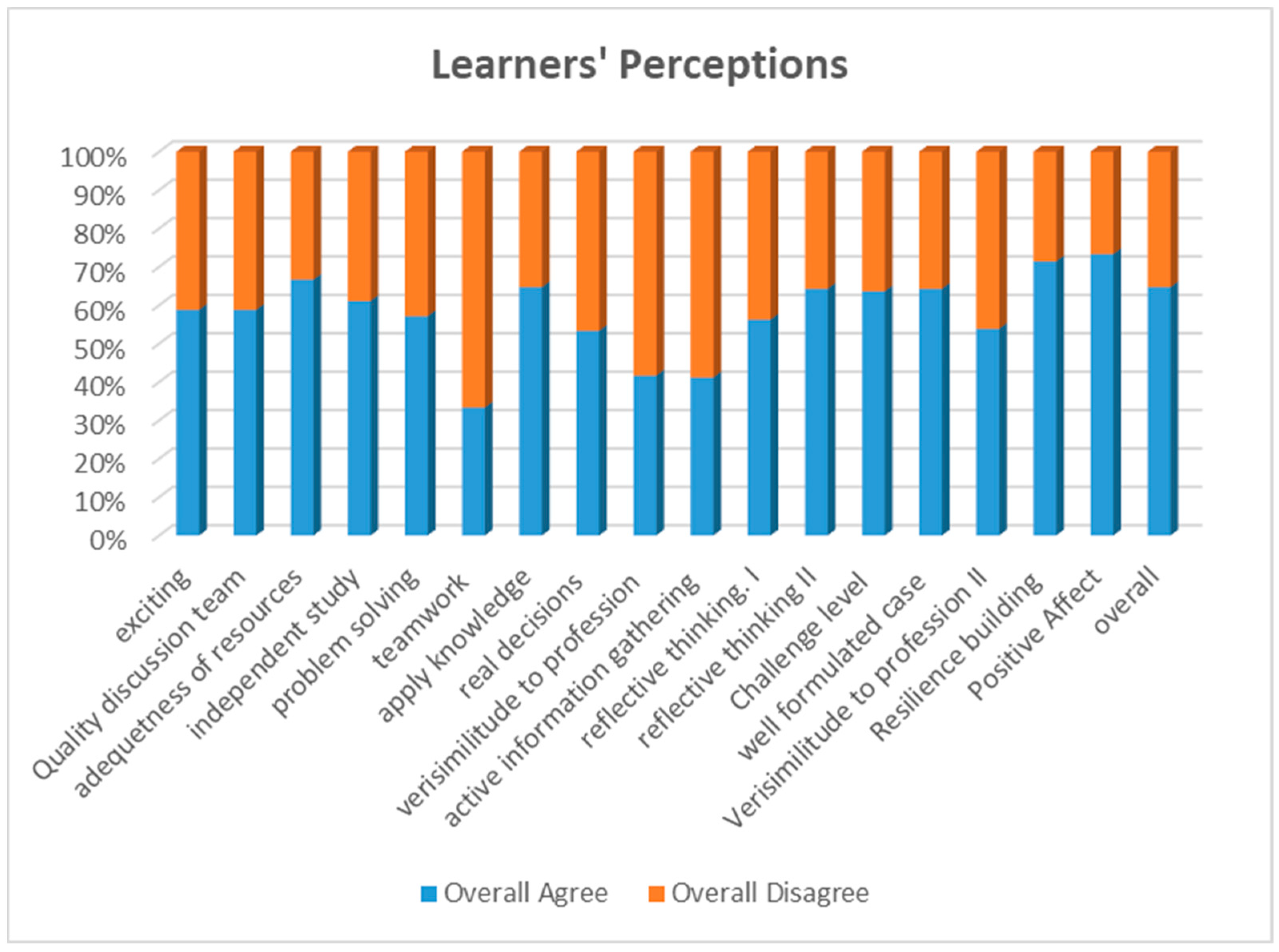Medical Education Escape Room Aligned with Flipped Classroom and Powered by Mobile Augmented Reality
Abstract
1. Introduction
1.1. Educational Escape Rooms
1.2. Flipped Learning Collaborative Learning in Medical Education
1.3. Pedagogies for Immersive Content
1.4. Aim and Scope of This Work
2. Materials and Methods
2.1. The AR Escape Room
- Personal protection equipment (PPE) use: The user has to find and put in the correct order the PPE for protection against a COVID-19-positive patient.
- Airway obstruction puzzle: The user has to identify possible trauma evidence, and if there is none, they must move the patient, as well as check for and remove airway obstructions.
- Vital signs taking: The user has to apply oximeter and sphygmomanometer and understand the meaning of the received vital signs.
- Defibrillation process: The user has to identify the morphology of pulses for which defibrillation is warranted.
- Glasgow Coma Scale puzzle: The user has to understand how to interpret reactions and clinical signs according to the Glasgow Coma Scale.
- Preparation for evacuation: The user encounters the essential preparatory materials for transport to ambulance or evacuation.
- Meta puzzle: This puzzle is a pure riddle for the learners. It aims to train them to think out of the box by posing a problem that should be solved out of the AR application.
2.2. Participants
2.3. Study Design and Procedure
- An introductory preclass presentation of the subject and the learning material: The learners were instructed to study resources about the workflow of BLS and be prepared to collaborate on a relevant in-class activity. At recruitment, the learners completed the baseline knowledge questionnaire.
- The flipped classroom episode: Then, they were instructed, in-class, to solve the AR escape room on their own as the initial activity, and they were prompted to ask any clarifying questions. The learners were asked to complete a preclass knowledge questionnaire before the activity.
- After that, the learners were debriefed on the correct workflow for BLS. and insights were offered based on facilitator class observations. After the activity, the learners completed the full postintervention battery of evaluation instruments, including the final knowledge questionnaire.
- The time frame of the flipped classroom educational activity is presented in Figure 5.
2.3.1. Data Collection and Instruments
2.3.2. Perceived Usefulness Instrument
2.3.3. Ad Hoc Knowledge Retention Instrument
3. Results
3.1. Perceived Usefulness Instrument
3.2. Ad Hoc Knowledge Retention Instrument
4. Discussion
4.1. Primary Results
- The overall educational experience was positively received and engaged the students.
- The AR escape room provided adequate content and level of challenge, as well as presented a well formulated case.
- The AR escape room encouraged reflective thinking and helped the learners build resilience in their problem-solving skills.
- The AR escape room in the Flipped Classroom format provided a measurable educational effect only as a whole episode. Self-study alone with the digital resource was not adequate for knowledge transfer and retention.
- The weakest points of the AR escape room were on teamwork and verisimilitude to a realistic situation. This was due to the format of the delivered FC episode, where each participant was individually engaged with the digital resource. Also, this is due to the highly gamified approach of the scenario that detracted from clinical realism. While this was a conscious choice (this was an introductory educational episode before actual clinical practice), it would be interesting to explore shifts in perceptions with a more complex scenario.
- Overall, the flipped classroom activity, utilizing an AR escape room, was deemed a positive educational activity, and feedback was pointing toward the need for further inclusion in curricular activities.
4.2. Limitations and Future Work
Author Contributions
Funding
Data Availability Statement
Conflicts of Interest
References
- Veldkamp, A.; van de Grint, L.; Knippels, M.C.P.; van Joolingen, W.R. Escape education: A systematic review on escape rooms in education. Educ. Res. Rev. 2020, 31, 100364. [Google Scholar] [CrossRef]
- Backhouse, A.; Malik, M. Escape into patient safety: Bringing human factors to life for medical students. BMJ Open Qual. 2019, 8, e000548. [Google Scholar] [CrossRef] [PubMed]
- Wilson, M.; Gerber, L.E. How generational theory can improve teaching: Strategies for working with the millennials. Curr. Teach. Learn. 2008, 1, 29–44. [Google Scholar]
- Rutledge, C.; Walsh, C.M.; Swinger, N.; Auerbach, M.; Castro, D.; Dewan, M.; Khattab, M.; Rake, A.; Harwayne-Gidansky, I.; Raymond, T.T.; et al. Gamification in action: Theoretical and practical considerations for medical educators. Acad. Med. 2018, 93, 1014–1020. [Google Scholar] [CrossRef] [PubMed]
- Poore, J.A.; Cullen, D.L.; Schaar, G.L. Simulation-based interprofessional education guided by Kolb’s experiential learning theory. Clin. Simul. Nurs. 2014, 10, e241–e247. [Google Scholar] [CrossRef]
- Ten Cate, O.T.J.; Kusurkar, R.A.; Williams, G.C. How self-determination theory can assist our understanding of the teaching and learning processes in medical education. AMEE guide No. 59. Med. Teach. 2011, 33, 961–973. [Google Scholar] [CrossRef]
- Lage, M.J.; Platt, G.J.; Treglia, M. Inverting the classroom: A gateway to creating an inclusive learning environment. J. Econ. Educ. 2000, 31, 30–43. [Google Scholar] [CrossRef]
- Låg, T.; Sæle, R.G. Does the flipped classroom improve student learning and satisfaction? A systematic review and meta-analysis. AERA Open 2019, 5, 2332858419870489. [Google Scholar] [CrossRef]
- Bishop, J.; Verleger, M.A. The flipped classroom: A survey of the re-search. In Proceedings of the 2013 ASEE Annual Conference Exposition, Atlanta, GA, USA, 23–26 June 2013; pp. 23–1200. [Google Scholar]
- Prince, M. Does active learning work? A review of the research. J. Eng. Educ. 2004, 93, 223–231. [Google Scholar] [CrossRef]
- Cheng, S.; Hwang, G.; Lai, C. Critical research advancements of flipped learning: A Review of the top 100 highly cited papers. Interact. Learn. Environ. 2022, 30, 1751–1767. [Google Scholar] [CrossRef]
- Berrett, D. How ‘flipping’ the classroom can improve the traditional lecture. Chron. High. Educ. 2012, 12, 1–3. [Google Scholar]
- Bloom, B.S. Taxonomy of Educational Objectives; Allyn and Bacon: Boston, MA, USA, 1984. [Google Scholar]
- Hung, H.T. Flipping the classroom for English language learners to foster active learning. Comput. Assist. Lang. Learn. 2015, 28, 81–96. [Google Scholar] [CrossRef]
- O’Flaherty, J.; Phillips, C. The Use of flipped classrooms in higher education: A Scoping review. Internet High. Educ. 2015, 25, 85–95. [Google Scholar] [CrossRef]
- Herreid, C.F.; Schiller, N.A.; Herreid, K.F.; Wright, C.B. A chat with the survey monkey: Case studies and the flipped classroom. J. Coll. Sci. Teach. 2014, 44, 75–80. [Google Scholar] [CrossRef]
- Del Brío-Alonso, I.; Cabanillas-García, J.L.; Sánchez-Gómez, M.C.; Franco-Martín, M. Mixed Study on the use of Flipped Classroom Methodology in the Subject of Community Mental Health Care. In Methodologies and Intelligent Systems for Technology Enhanced Learning, Proceedings of the 13th International Conference. MIS4TEL 2023, Guimaraes, Portugal, 12–14 July 2023; Lecture Notes in Networks and Systems; Milrad, M., Otero, N., Sánchez, M.C., Mena, J.J., Durães, D., Sciarrone, F., Alvarez-Gómez, C., Rodrigues, M., Vittorini, P., Gennari, R., et al., Eds.; Springer: Cham, Switzerland, 2023; Volume 764, pp. 23–33. [Google Scholar] [CrossRef]
- Scott, G.W.; Furnell, J.; Murphy, C.M.; Goulder, R. Teacher and student perceptions of the development of learner autonomy; a case study in the biological sciences. Stud. High. Educ. 2015, 40, 945–956. [Google Scholar] [CrossRef]
- Thomas, L.; Hockings, C.; Ottaway, J.; Jones, R. Independent Learning: Students’ Perspectives and Experiences; Higher Education Academy: London, UK, 2015. [Google Scholar]
- Ross, B.H. Psychology of Learning and Motivation: Advances in Research and Theory; Elsevier: Amsterdam, The Netherlands, 2002. [Google Scholar]
- Murphy, P.; Hall, K.; Soler, J. (Eds.) Pedagogy and Practice: Culture and Identities; Sage: Melbourne, VIC, Australia, 2012. [Google Scholar]
- Cabanillas-García, J.L.; Rodríguez-Jiménez, C.J.; Sánchez-Gómez, M.C.; Losada-Vázquez, Á.; Losada-Moncada, M.; Corrales-Vázquez, J.M. Observational Study of Experiential Activities Linked to Astronomy with CAQDAS NVivo. In Computer Supported Qualitative Research, WCQR 2023; Lecture Notes in Networks and Systems; Costa, A.P., Moreira, A., Freitas, F., Costa, K., Bryda, G., Eds.; Springer: Cham, Switzerland, 2023; Volume 688. [Google Scholar] [CrossRef]
- Rost, M. Generating Student Motivation. WorldView. 2006, pp. 1–4. Available online: https://www.slideshare.net/slideshow/generating-student-motivation-michael-rost/78525267 (accessed on 11 June 2024).
- Antoniou, P.E. Implementing digital learning for health. In Digital Innovations in Healthcare Education and Training; Academic Press: Cambridge, MA, USA, 2021; pp. 103–125. [Google Scholar]
- Shin, J.E.; Kim, H.; Park, H.; Woo, W. Investigating the Design of Augmented Narrative Spaces Through Virtual-Real Connections: A Systematic Literature Review. In Proceedings of the CHI Conference on Human Factors in Computing Systems, Honolulu, HI, USA, 11–16 May 2024; pp. 1–18. [Google Scholar]
- Roig, P.J.; Alcaraz, S.; Gilly, K.; Bernad, C.; Juiz, C. A Generic Multilevel Structure for Educational Escape Rooms. Educ. Sci. 2024, 14, 488. [Google Scholar] [CrossRef]
- Damaševičius, R.; Sidekerskiene, T. Designing gamified augmented reality-based escape rooms. In Proceedings of the GAMOTEC 2023: International Workshop on Gamification and Motivational Technologies (GAMOTEC), Online, 29–30 November 2023; University of Zaragoza: Zaragoza, Spain, 2023; Volume 3, pp. 123–127. [Google Scholar]
- Fides-Valero, A.; Bray, L.; Dieckmann, P.; Antoniou, P.; Lahtinen, P.; Bamidis, P.; Nikolaidou, M. Creating and running an escape room for healthcare curricula: AMEE Guide No. 168. Med. Teach. 2024, 1–12. [Google Scholar] [CrossRef] [PubMed]






| The FC activity generated high quality discussion in the group. |
| The FC activity was exciting. |
| The FC activity generated high quality discussion in the group. |
| I was given all the resources I needed to get the most out of the FC session. |
| The FC session encouraged me to learn independently. |
| The FC session helped me develop my problem-solving skills. |
| The FC session allowed me to work as part of a team. |
| The FC session gave me the opportunity to apply the knowledge I already have. |
| While working on the case, I felt that I had to make decisions as a true professional. |
| While working on the case, I felt like I was the professional doing the analysis. |
| While working on the case, I was actively involved in gathering information (e.g., evidence, objective of analysis) needed to solve the case |
| While working on the case, I was actively engaged in revising my initial ideas about the necessary decisions with the new information I gained. |
| While working on the case, I actively engaged in thinking about what findings supported or contradicted my ideas and conclusions. |
| I felt the case was at an appropriate level of difficulty for my level of training. |
| The case questions helped to enhance the diagnostic assessment of the case. |
| After completing the case, I feel better prepared to act as a professional in a real incident analysis. |
| After completing the case, I feel better prepared to handle the positives and negatives in a real situation. |
| After the conclusion of the case, I feel better prepared to make an analysis of the situations that developed. |
| Overall, the case was a worthwhile learning experience. |
| Prestudy Questions | Questions | Postsession Questions |
|---|---|---|
| What is the first action to a fallen person? | Which action is not part of the chain of survival? | What are the main stages of BLS? |
| What is the frequency of chest compressions in CPR? | What is the correct order in BLS? | After five cycles of CPR the patient remains pulseless, what do you do next? |
| What should approximately the compression depth during chest compressions be? | In automatic external defibrillator, what is the correct sequence of energies? | Identify the defibrillation rhythm in the figures below. |
| What is the correct ratio of chest compressions/infusions in CPR? | What are the main points of basic life support? | Select the correct sequence that describes the chain of survival. |
| What do you do immediately after delivering an automatic external defibrillator shock? | Which are the points of airway obstruction? | Select the correct sequence for wearing Personal protection equipment. |
| TELSON-WAVES Questionnaire | Aspects of Perceived Usefulness | Figure 5 Shorthand |
|---|---|---|
| The FC activity was exciting. | excitement/engagement | exciting |
| The FC activity generated high quality discussion in the group. | quality discussion team | quality discussion team |
| I was given all the resources I needed to get the most out of the FC session. | adequateness of resources | adequateness of resources |
| The FC session encouraged me to learn independently. | independent study | independent study |
| The FC session helped me develop my problem-solving skills. | problem solving | problem solving |
| The FC session allowed me to work as part of a team. | teamwork | teamwork |
| The FC session gave me the opportunity to apply the knowledge I already have. | knowledge application | apply knowledge |
| While working on the case, I felt that I had to make decisions as a true professional. | real decisions making | real decisions |
| While working on the case, I felt like I was the professional doing the analysis. | verisimilitude to profession I | verisimilitude to profession |
| While working on the case, I was actively involved in gathering information (e.g., evidence, objective of analysis) needed to solve the case | active information gathering | active information gathering |
| While working on the case, I was actively engaged in revising my initial ideas about the necessary decisions with the new information I gained. | reflective thinking I | reflective thinking I |
| While working on the case, I actively engaged in thinking about what findings supported or contradicted my ideas and conclusions. | reflective thinking II | reflective thinking II |
| I felt the case was at an appropriate level of difficulty for my level of training. | challenge level | challenge level |
| The case questions helped to enhance the diagnostic assessment of the case. | well-formulated case | well-formulated case |
| After completing the case, I feel better prepared to act as a professional in a real incident analysis. | verisimilitude to profession II | verisimilitude to profession II |
| After completing the case, I feel better prepared to handle the positives and negatives in a real situation. | resilience building | resilience building |
| After the conclusion of the case, I feel better prepared to make an analysis of the situations that developed. | positive affect | positive affect |
| Overall, the case was a worthwhile learning experience. | overall opinion | overall |
| Successfully Answered Questions (Out of a Total of 5) | |||
|---|---|---|---|
| Mean | SD | N | |
| Prestudy (Baseline) | 2.62 | 1.32 | 21 |
| Preclass (Self-study) | 2.76 | 0.95 | 21 |
| Postclass (After FC Activity) | 4.14 | 0.79 | 21 |
Disclaimer/Publisher’s Note: The statements, opinions and data contained in all publications are solely those of the individual author(s) and contributor(s) and not of MDPI and/or the editor(s). MDPI and/or the editor(s) disclaim responsibility for any injury to people or property resulting from any ideas, methods, instructions or products referred to in the content. |
© 2024 by the authors. Licensee MDPI, Basel, Switzerland. This article is an open access article distributed under the terms and conditions of the Creative Commons Attribution (CC BY) license (https://creativecommons.org/licenses/by/4.0/).
Share and Cite
Antoniou, P.E.; Papamalis, F.; Dafli, E.; Poultourtzidis, I.; Schwarz, D.; Woodham, L.; Dimitriadis, S.; Tagaras, K.; Kyriakidis, N.; David, P.; et al. Medical Education Escape Room Aligned with Flipped Classroom and Powered by Mobile Augmented Reality. Electronics 2024, 13, 2367. https://doi.org/10.3390/electronics13122367
Antoniou PE, Papamalis F, Dafli E, Poultourtzidis I, Schwarz D, Woodham L, Dimitriadis S, Tagaras K, Kyriakidis N, David P, et al. Medical Education Escape Room Aligned with Flipped Classroom and Powered by Mobile Augmented Reality. Electronics. 2024; 13(12):2367. https://doi.org/10.3390/electronics13122367
Chicago/Turabian StyleAntoniou, Panagiotis E., Fivos Papamalis, Eleni Dafli, Ioannis Poultourtzidis, Daniel Schwarz, Luke Woodham, Sarantis Dimitriadis, Konstantinos Tagaras, Nikolaos Kyriakidis, Panagiotis David, and et al. 2024. "Medical Education Escape Room Aligned with Flipped Classroom and Powered by Mobile Augmented Reality" Electronics 13, no. 12: 2367. https://doi.org/10.3390/electronics13122367
APA StyleAntoniou, P. E., Papamalis, F., Dafli, E., Poultourtzidis, I., Schwarz, D., Woodham, L., Dimitriadis, S., Tagaras, K., Kyriakidis, N., David, P., Nikolaidou, M., Skříšovská, T., Poulton, T., & Bamidis, P. D. (2024). Medical Education Escape Room Aligned with Flipped Classroom and Powered by Mobile Augmented Reality. Electronics, 13(12), 2367. https://doi.org/10.3390/electronics13122367








